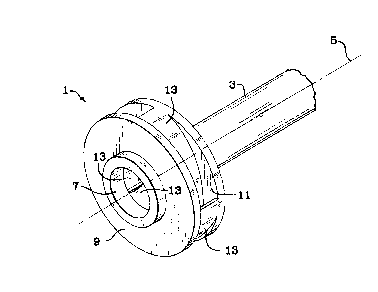Some of the information on this Web page has been provided by external sources. The Government of Canada is not responsible for the accuracy, reliability or currency of the information supplied by external sources. Users wishing to rely upon this information should consult directly with the source of the information. Content provided by external sources is not subject to official languages, privacy and accessibility requirements.
Any discrepancies in the text and image of the Claims and Abstract are due to differing posting times. Text of the Claims and Abstract are posted:
| (12) Patent: | (11) CA 2068854 |
|---|---|
| (54) English Title: | IMPELLER FOR CENTRIFUGAL PUMPS |
| (54) French Title: | ROUE A AILETTES POUR POMPES CENTRIFUGES |
| Status: | Term Expired - Post Grant Beyond Limit |
| (51) International Patent Classification (IPC): |
|
|---|---|
| (72) Inventors : |
|
| (73) Owners : |
|
| (71) Applicants : |
|
| (74) Agent: | NORTON ROSE FULBRIGHT CANADA LLP/S.E.N.C.R.L., S.R.L. |
| (74) Associate agent: | |
| (45) Issued: | 1998-04-07 |
| (22) Filed Date: | 1992-05-15 |
| (41) Open to Public Inspection: | 1992-12-22 |
| Examination requested: | 1992-05-15 |
| Availability of licence: | N/A |
| Dedicated to the Public: | N/A |
| (25) Language of filing: | English |
| Patent Cooperation Treaty (PCT): | No |
|---|
| (30) Application Priority Data: | ||||||
|---|---|---|---|---|---|---|
|
A cavitation resistant impeller for liquid-conveying centrifugal
pumps has a plurality of impeller vanes, each vane having, in
combination, a leading inlet edge with a root portion extending
upstream of its tip portion; a vane thickness that is greater
upstream of the impeller throat than the vane thickness
downstream of the impeller throat; and an elliptical nose on the
leading inlet edge. The invention can be used in straight-vaned
impellers or in Francis-type impellers.
Cette invention concerne une roue anticavitation de pompe centrifuge à liquides, qui comporte une série d'aubes ayant, chacune, un bord d'attaque à l'aspiration dont la racine est en amont par rapport à son extrémité; une épaisseur qui est plus grande en amont de l'ouïe qu'en amont de celle-ci; et un nez elliptique sur le bord d'attaque à l'aspiration aspiration. Cette invention peut être adaptée aux roues à aubes radiales ou aux roues de type Francis.
Note: Claims are shown in the official language in which they were submitted.
Note: Descriptions are shown in the official language in which they were submitted.

2024-08-01:As part of the Next Generation Patents (NGP) transition, the Canadian Patents Database (CPD) now contains a more detailed Event History, which replicates the Event Log of our new back-office solution.
Please note that "Inactive:" events refers to events no longer in use in our new back-office solution.
For a clearer understanding of the status of the application/patent presented on this page, the site Disclaimer , as well as the definitions for Patent , Event History , Maintenance Fee and Payment History should be consulted.
| Description | Date |
|---|---|
| Inactive: Expired (new Act pat) | 2012-05-15 |
| Inactive: IPC from MCD | 2006-03-11 |
| Letter Sent | 2002-06-19 |
| Inactive: Correspondence - Transfer | 2002-04-16 |
| Inactive: Multiple transfers | 2002-04-16 |
| Inactive: Office letter | 2002-02-22 |
| Inactive: Multiple transfers | 2002-01-16 |
| Grant by Issuance | 1998-04-07 |
| Inactive: Application prosecuted on TS as of Log entry date | 1998-01-28 |
| Inactive: Status info is complete as of Log entry date | 1998-01-28 |
| Pre-grant | 1997-09-22 |
| Notice of Allowance is Issued | 1997-04-22 |
| Application Published (Open to Public Inspection) | 1992-12-22 |
| All Requirements for Examination Determined Compliant | 1992-05-15 |
| Request for Examination Requirements Determined Compliant | 1992-05-15 |
There is no abandonment history.
| Fee Type | Anniversary Year | Due Date | Paid Date |
|---|---|---|---|
| Final fee - standard | 1997-09-22 | ||
| MF (patent, 6th anniv.) - standard | 1998-05-15 | 1998-04-23 | |
| MF (patent, 7th anniv.) - standard | 1999-05-17 | 1999-04-20 | |
| MF (patent, 8th anniv.) - standard | 2000-05-15 | 2000-04-20 | |
| MF (patent, 9th anniv.) - standard | 2001-05-15 | 2001-04-19 | |
| Registration of a document | 2002-01-16 | ||
| MF (patent, 10th anniv.) - standard | 2002-05-15 | 2002-04-19 | |
| MF (patent, 11th anniv.) - standard | 2003-05-15 | 2003-04-22 | |
| MF (patent, 12th anniv.) - standard | 2004-05-17 | 2004-04-21 | |
| MF (patent, 13th anniv.) - standard | 2005-05-16 | 2005-04-20 | |
| MF (patent, 14th anniv.) - standard | 2006-05-15 | 2006-04-18 | |
| MF (patent, 15th anniv.) - standard | 2007-05-15 | 2007-04-17 | |
| MF (patent, 16th anniv.) - standard | 2008-05-15 | 2008-04-17 | |
| MF (patent, 17th anniv.) - standard | 2009-05-15 | 2009-04-17 | |
| MF (patent, 18th anniv.) - standard | 2010-05-17 | 2010-04-19 | |
| MF (patent, 19th anniv.) - standard | 2011-05-16 | 2011-04-18 |
Note: Records showing the ownership history in alphabetical order.
| Current Owners on Record |
|---|
| FLOWSERVE MANAGEMENT COMPANY |
| Past Owners on Record |
|---|
| DONALD P. SLOTEMAN |
| PAUL COOPER |